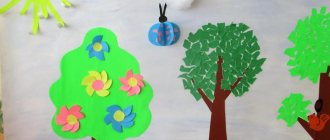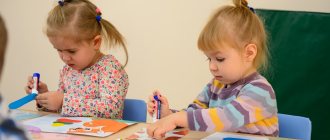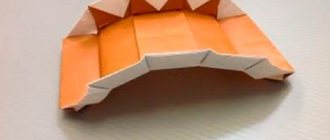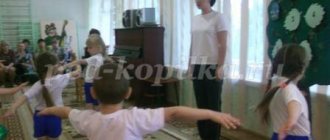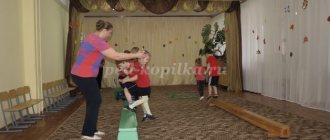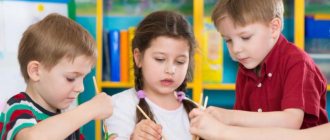Abstract of GCD: design according to a model in the middle group on the topic “Tower”.
Chermakova Anna Nikolaevna
senior teacher,
MBDOU "Kindergarten No. 127",
Cheboksary, Chuvash Republic, Russia
Abstract of GCD: design according to a model in the middle group on the topic “Tower”.
Annotation.
This article reveals the experience of working with preschoolers in designing from building material on the theme “Tower” for children 4-5 years old.
Keywords:
“Tower”, brick, ceiling, roof, building, pyramids, etc.
Target:
formation of design skills in preschool children.
Tasks:
— To develop in children the ability to build a tower using building materials: cubes, bricks, prisms of different colors.
— Continue to teach how to build vertical buildings by laying down parts (cubes, bricks) and floors.
— Learn to complete the construction by choosing the material yourself.
— To develop in children the ability to analyze a sample, highlighting shape, color, symmetry.
-Develop vocabulary: tall building, stable, symmetrical.
Material:
Toy Bear, envelope with letter, building material: bricks, plates, pyramids; toy characters from the fairy tale “Teremok”.
Preliminary work:
reading the Russian folk tale "Teremok".
Methodical techniques:
1. Game situation:
Educator.
Guys, you know, today the postman brought us... what do you guys think he brought us? That's right, the postman brought us a letter, this letter was sent to us by Mishka. Let's read what Mishka writes to us.
The teacher takes out the letter and reads:
"Hello guys! I am writing this letter to you and I want you to help me in my trouble, one day my friends: a mouse, a frog, a bunny, a fox and a top invited me to visit their little house. But when I came to visit them and wanted to go into the mansion, I saw that the mansion was too small for me. Then my friends invited me to stay on their roof. I climbed onto the roof and just sat down - bam! And crushed the tower. The tower crackled, fell on its side and completely fell apart. My friends barely had time to jump out of it. I want to ask you guys to build a big, beautiful and strong tower for me and my friends. I thank all the guys in advance, your Mishka.”
2. Questions for children:
-Do you guys want to help Mishka? (Children's answers).
- Do you want to build a tall, beautiful and strong tower for him? (Children's answers).
Educator.
And you guys know, in order to build such a tower, you must first learn how to build it. Do you want to learn? Then listen to me carefully, and I will teach you how to build a tower like this.
3.Examination of the building.
Questions for children:
— Guys, do you like this building? (children's answers)
-What kind of building is this? (children's answers)
Abstract of GCD for design in the middle group “Steam locomotive with carriage”
Abstract of GCD for design: “DESIGN ACCORDING TO THE “SIDE VIEW” SCHEME OF A STEAM LOGO WITH A CARRIAGE” (middle group)
Target
: to improve children’s design skills using a ready-made construction scheme.
Educational objectives:
— Strengthen the ability to analyze ready-made graphic models of the design of objects (locomotive and carriage).
— To consolidate the skill of implementing a design diagram (a locomotive with a carriage) in construction. Developmental tasks
: - Clarify children's knowledge about the train as a form of transport.
— Expand your horizons. Educational objectives
: - To consolidate the skill of coordinating the actions of children with each other in joint work, to develop cooperation skills.
Materials and equipment
: — demonstration diagrams of a locomotive and a carriage (side view), similar distribution diagrams; - handout building material corresponding to the proposed diagrams (plus similar demonstration material for analyzing the diagrams of a steam locomotive and carriage): * for a steam locomotive - a long brick, 2 bricks smaller than average, 4 thick bars, 2 small bricks, 2 small triangular prisms, a cylinder; * for a carriage – 2 long bricks, 4 cubes, 2 small triangular prisms, 2 medium bricks, 2 small half-cubes; — animated video “Locomotive Bukashka”; — multimedia presentation-accompaniment; - magnetic board; - laptop; - projection screen.
1. Organizational stage
Pedagogical goal
: to create playful motivation for constructive activities, to evoke an emotional response in children, to develop imagination and cognitive activity.
Children's goal :
remember familiar types of transport, strengthen the ability to solve riddles.
Methods and techniques :
guessing riddles, conversation.
— Guys, do you like to travel? (Yes) - How can you go on a trip? (By car, by bus, by plane, etc.) - And I suggest you go to visit the animals on... Try to guess this type of transport yourself: A Centipede rushes along steel paths. Knock-knock-knock, round heel clicks. With a cheerful song along the iron ladder. (Train) - Our train will be built from building material.
2. Stage based on children’s personal experience
Pedagogical goal :
to clarify children’s knowledge about the train as a form of transport, to enhance children’s personal experience, to broaden their horizons.
Children's goal :
remember everything they know about the train.
Methods and techniques :
problematic questions, demonstration of a multimedia presentation, teacher's story, indirect hint, leading questions, praise.
— Guys, how many of you have traveled by train, please raise your hands? There are so many travelers in our group! Let's check what you know about this type of transport! *Children sit in front of the projection screen. — What type of transport is the train: land, water or air? (A train is a ground transport) - slide number 2. - Remember what parts the train consists of? (From a steam locomotive and carriages) - slide number 3. - Why does a train need a steam locomotive? (It pulls cars behind it because it has an engine) - slide number 4. - What types of trains are there? (Passenger trains transport people, and freight trains carry different types of cargo) - slides No. 5-7. * Did you know that the fastest (super-fast) train in the world carries passengers in Japan. This is a magnetic levitation train; it does not touch the rails, but “floats” above them. Such a super-high-speed train is 5-6 times faster than a regular train (slide No. 8). And in the near future, Russian double-decker trains will carry participants and guests of the Winter Olympics to Sochi (slide No. 9) - Without what can the train not go on a trip? (He needs rails - a railroad). —Who controls the train? (Driver) - slide number 10. Well done, you know a lot about trains!
3. Main stage
Pedagogical goal :
to consolidate in children the ability to analyze ready-made graphic models of the design of objects (locomotive and carriage);
consolidate the skill of implementing a design diagram (a locomotive with a carriage) in a building; to develop the skill of coordinating children’s actions with each other (cooperation). Children's goal :
to figure out what parts will be needed to build a steam locomotive and a carriage;
build a steam locomotive with a carriage together with a friend. Methods and techniques :
analysis of building diagrams, correlation of diagrams with the existing set of building parts, conversation, indirect hints, praise, independent construction according to the diagram. — To build our own train, we will need drawings of a steam locomotive and a carriage depicting the necessary construction parts. *Schemes are posted on a magnetic board. - Let's look at them carefully (from bottom to top). Let's start with the locomotive.
*A sequential analysis of the locomotive diagram (side view) is being carried out. Children can match the parts proposed for building a steam locomotive with the diagram.
— What construction parts will we use to make the wheels? (From triangular prisms) - What building part will be needed for the base of the locomotive? (Long brick) - Our locomotive has 2 main parts - front and rear. What's in the front? (Engine, pipe) And in the back? (Driver's Cabin) - List the construction parts for the front of the locomotive. (Whetstones, small brick). Specify where the small brick will be located? (Ahead) - What parts will be needed for the walls of the driver's cab? (The bricks are smaller than average) And for the door? (Bar) What will we make the roof of the cabin from? (From small bricks) - What will we make the locomotive pipe out of? (From the cylinder)
*During the conversation, the teacher uses indirect hints, leading questions, and praise. — Now let’s look at the drawing of the carriage (also from bottom to top).
Are the wheels of a carriage and a steam locomotive similar? (Yes) So they will be made from the same building parts. Name them (triangular prisms). — Is the base of the carriage the same as that of a steam locomotive? (Yes) Which construction part will we take? (Long brick) - What building parts will be needed to build the walls of the carriage? (Cubes, medium bricks). — What construction parts will be needed for window partitions? (Half cubes). — What will we make the roof of the carriage from? (Made from a long brick). — We found out what parts our train will be built from. Let's take a little rest. *Physical training: Up and down hand jerks, as if we were waving flags. Let's stretch our shoulders. Hands move towards. (One hand up, the other down, change hands with jerks.) Hands on your sides. Smile. Lean left and right. (Bend to the sides.) Start squats. Don't rush, don't lag behind. (Squats.) And at the end - walking in place. Everyone has known this for a long time. (Walk in place.)
- Now I suggest you build your own train for our journey to the animals! You will build in pairs. Agree which of you will build a locomotive and which will build a carriage, and take a suitable box of building material and a drawing.
*During independent work, the skill of coordinating children’s actions with each other (cooperation) is consolidated. Upon completion of construction, children combine the locomotive with the carriage into a train.
4. Consolidating children's knowledge
Pedagogical goal:
consolidate the skill of correlating a building with a design diagram (locomotive and carriage).
Children's goal :
help a friend build a train.
Methods and techniques :
correlation of the finished building with the diagram, praise, encouragement. The teacher invites the children to check their partner’s construction and, if necessary, make adjustments to it in accordance with the drawings.
*Tick the children who worked together and helped each other.
5. Final stage
Pedagogical goal :
reflection;
motivation for further knowledge of modes of transport. The goal is for children :
to think whether everything that was planned was successful.
Methods and techniques :
watching a video, conversation, gift for children.
Children go by train to visit the animals (slide No. 11). There is an image of animals on the projection screen (slide No. 12). — Hello, guys, how did you come to us? (on the train) - Really, you built it yourself? Well done! Was it easy for you to build the train? What was the hardest thing? Did you help each other? Did everything work out for you? — Want to know more about trains and other modes of transport? (Yes) This book will help you with this (Encyclopedia “Transport”). — Now let’s all take a train ride together (watch the animated video “Bukashka the Steam Locomotive”) - slide number 13.
